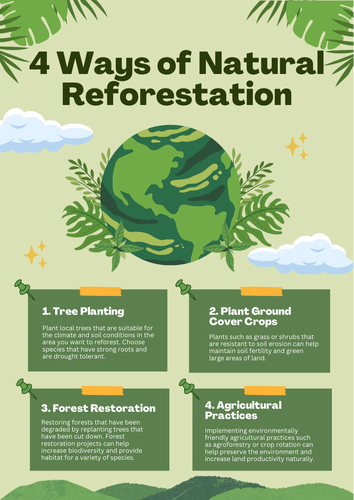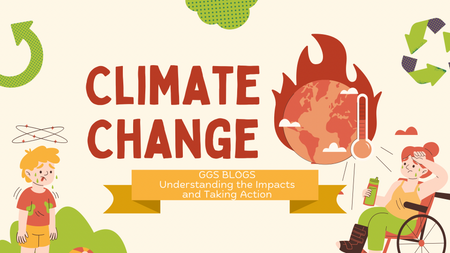MUHAMMAD, company.com
4 WAYS OF NATURAL REFORESTATION

Natural reforestation, also known as natural regeneration, is the process where forests regenerate naturally through the natural growth of trees from seeds, sprouts, or seedlings without the need for human intervention such as planting. It plays an essential role in environmental sustainability and offers several significant benefits. Here's why natural reforestation is important:
1. Environmental Benefits:
- Biodiversity Conservation: Natural reforestation helps restore ecosystems and provides habitats for a variety of species, improving biodiversity. Unlike monoculture plantations, natural regeneration allows a diverse mix of plant and animal species to thrive.
- Carbon Sequestration: Forests act as carbon sinks, absorbing carbon dioxide (CO₂) from the atmosphere. Natural reforestation contributes to the reduction of greenhouse gases, helping combat climate change.
- Soil Protection: Forests prevent soil erosion by stabilizing the soil with their root systems, reducing the risk of landslides, especially in hilly or mountainous regions.
- Water Regulation: Healthy forests regulate water cycles by maintaining groundwater levels and reducing the risk of flooding. Forests act as natural sponges, capturing and slowly releasing water into rivers and streams.
- Air Quality Improvement: Trees in regenerating forests filter pollutants from the air and release oxygen, improving air quality and promoting overall public health.
2. Cost-Effectiveness:
- Lower Costs: Unlike tree planting, which involves significant human effort, resources, and costs, natural reforestation requires minimal intervention. By allowing nature to take its course, the process is more cost-effective in the long run.
- Self-sustaining Process: Once natural reforestation is underway, it becomes a self-sustaining process that does not require continuous maintenance or external inputs (e.g., water, fertilizers, or pesticides).
3. Faster Recovery of Ecosystems:
- Accelerated Regrowth: In many cases, natural reforestation leads to faster ecosystem recovery compared to artificial reforestation or tree planting. The process can begin more quickly as existing plants, seeds, and natural processes start to regenerate the forest.
- Resilience: Forests regenerated naturally are often more resilient to pests, diseases, and environmental stresses because they maintain greater biodiversity and ecological balance.
4. Improved Climate Adaptation:
- Enhanced Ecosystem Services: Natural reforestation supports ecological processes such as nutrient cycling, water filtration, and pest control, which strengthen ecosystems' resilience to climate change.
- Adaptability to Local Conditions: Since natural reforestation relies on the area's native species and ecological conditions, the resulting forests are better adapted to local climates and environmental challenges.
5. Cultural and Community Benefits:
- Community Engagement: In many regions, natural reforestation allows local communities to engage in forest management and stewardship. This fosters a sense of ownership and responsibility, leading to more sustainable practices.
- Livelihoods: Regenerating forests provide opportunities for sustainable forest management practices, which can be linked to the collection of non-timber forest products, ecotourism, and sustainable harvesting of wood resources.
6. Long-Term Sustainability:
- Sustainable Forest Growth: Natural reforestation creates forests that are more diverse and complex, often ensuring a sustainable supply of timber, fuelwood, and other resources for local populations over the long term.
- Reduced Need for External Inputs: Since natural regeneration uses the existing seed bank, soil, and other ecological processes, it generally requires fewer external inputs and labor compared to artificial planting.
Challenges of Natural Reforestation:
While natural reforestation has many benefits, there are some challenges to consider:
- Invasive Species: Non-native plants or pests can hinder natural regeneration, making it difficult for native species to reestablish themselves.
- Land Use and Human Activity: If the land is heavily impacted by agriculture, urbanization, or other forms of land use, natural reforestation may be slow or may require interventions like removing invasive species or protecting the area from further disturbances.
- Climate Change: Changes in temperature, rainfall patterns, and extreme weather events may affect the success and speed of natural reforestation in some regions.
Conclusion:
Natural reforestation is a sustainable and effective approach to forest restoration that offers a range of environmental, economic, and social benefits. By allowing ecosystems to regenerate naturally, it contributes to biodiversity conservation, climate change mitigation, and the restoration of critical ecosystem services. However, successful natural reforestation requires protection from external threats such as invasive species and human encroachment.


